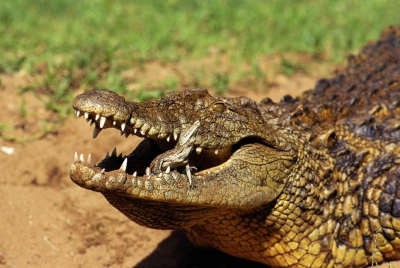
The Nile crocodile has a somewhat deserved reputation as a vicious man-eater. The proximity of much of its habitat to people means run-ins are frequent. And its virtually indiscriminate diet means a villager washing clothes by a riverbank might look just as tasty as a migrating wildebeest. Firm numbers are sketchy, but estimates are that up to 200 people may die each year in the jaws of a Nile croc.
Africa’s largest crocodilian can reach a maximum size of about 20 feet and can weigh up to 1,650 pounds. Average sizes, though, are more in the range of 16 feet and 500 pounds. They live throughout sub-Saharan Africa, the Nile Basin, and Madagascar in rivers, freshwater marshes, and mangrove swamps.
The diet of the Nile crocodile is mainly fish, but it will attack almost anything unfortunate enough to cross its path, including zebras, small hippos, porcupines, birds, and other crocodiles. It will also scavenge carrion, and can eat up to half its body weight at a feeding.
Hunted close to extinction in the 1940s through the 1960s, local and international protections have helped them rebound in most areas. In some regions, though, pollution, hunting, and habitat loss have severely depleted their numbers.
One unusual characteristic of this fearsome predator is its caring nature as a parent. Where most reptiles lay their eggs and move on, mother and father Nile crocs ferociously guard their nests until the eggs hatch, and they will often roll the eggs gently in their mouths to help hatching babies emerge.
Credit : National Geographic
Picture Credit : Google




